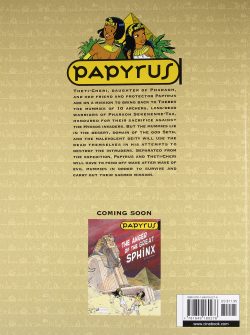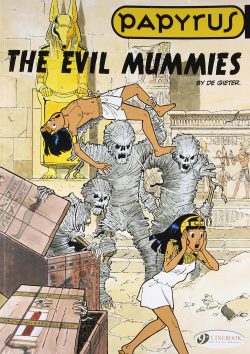

By Lucien De Geiter, coloured by Georges Vloeberghs & translated by Luke Spear (Cinebook)
ISBN: 978-1-84918-027-6 (Album PB)
Papyrus is the masterfully evocative magnum opus of Belgian cartoonist Lucien de Gieter. It premiered in 1974 in legendary weekly Le Journal de Spirou, running to 35 collected albums, and consequently spawning a wealth of merchandise, including an animated television show and a video game.
De Gieter was born in 1932 and studied at Saint-Luc Art Institute in Brussels before going into industrial design and interior decorating. He made the jump into sequential narrative in 1961, first through “mini-récits†(fold-in, half-sized booklets) inserted into LJdS, starring his jovial little cowboy Pony, and later by writing for art-star regulars such as Kiko, Jem, Eddy Ryssack and Francis. After that he joined Peyo’s studio as inker on Les Schtroumpfs (The Smurfs) and took over the long-running newspaper strip Poussy.
In the 1960s, De Gieter launched South Seas mermaid fantasy Tôôôt et Puit whilst Pony was promoted to the full-sized pages of Spirou, deep-sixing the Smurfs gig to expand his horizons working for Le Journal de Tintin and Le Journal de Mickey.
From 1972-1974, De Gieter assisted cartooning legend Berck on Mischa for Germany’s Primo, whilst applying the finishing touches to his latest project: a historical confection which would occupy his full attention and delight millions of fervent fans for the next forty years…
The annals of Papyrus encompass a huge range of themes and milieux, blending Boy’s Own adventure with historical fiction and interventionist mythology: the epic yarns gradually evolving from traditionally appealing “Bigfoot†cartoon style and content towards a more realistic, dramatic and authentic iteration, through means of light fantasy romps always leavened and flavoured with the latest historical theories and discoveries.
The named star is a fearlessly forthright peasant lad (specifically, a fisherman by trade) favoured by the gods who rises to become a hero of Egypt and friend to Pharaohs.
As a youngster the plucky Fellah was blessed by the divine powers and given a magic sword, courtesy of a daughter of crocodile-headed Sobek. The lad’s first task was to free supreme god Horus from imprisonment in the Black Pyramid of Ombos, thereby restoring peace to the Double Kingdom. However, his most difficult and seemingly never-ending duty is protecting Pharaoh’s wilful, high-handed and insanely danger-seeking daughter Theti-Cheri – a princess with an unparalleled gift for seeking out trouble…
The Evil Mummies is the fourth Cinebook tome (of, inexplicably, only six thus far). Available in paperback and in eBook formats, it translates the 19th European album in the run, which was originally released in 1996 as Les Momies maléfiques: a riotous rollercoaster of all-out action and fearsome fantasy which begins in the rocky fastnesses of the deep sands. Here Pharaoh’s headstrong daughter impatiently leads an expedition to retrieve the revered mummies of the fabled Ten Archers of Sekenenre Taa from the lost Hammamat mines, who legendarily fell defending the nation from the invading Hyksos.
The bodies are to be returned in honour and interred in Thebes, but first they have to find them…
Cheekily joining Theti-Cheri, her protector Papyrus and all the assorted, hurrying specialists is sometime court jester Puin, charged with caring for the precious pack animals – although it would be more accurate to say that his phenomenally intelligent donkey Khamelot is actually guiding all those reins…
In their haste to finish the mission, the party are shamefully negligent and forget to make proper obeisance to divine Seth, Master of the Desert Wastes, and soon a furious cloud image warns of the dark overlord’s wrath. Nervously shrugging it off, the expedition prepares for sleep but is suddenly devastated by a terrifying flash-flood manifesting from nowhere and brutally scattering the impious intruders.
Papyrus awakes battered and bruised above a lofty precipice. He has been saved from crushing doom by a great silver falcon, favoured beast of mighty Horus…
In trying to retrieve his magic sword the boy-hero triggers a flaming omen which points him a certain direction. Setting off into the scorching desert, he slowly follows a treacherous trail and with the falcon’s timely aid uncovers a deep crevice and shaft into a deep, long-forgotten mine. In a chamber far within the abandoned workings is a golden statue of Seth and ten roughly hewn coffins in a makeshift temple…
Curiosity overcoming caution, Papyrus uncovers a ghastly, poorly-preserved mummy in one but the second – already opened – casque holds Theti-Cheri herself: alive, but bound and gagged. When he cuts the princess loose, she descends into utter panic, frantically warning that she had been captured by walking corpses: the angry archers of Sekenenre Taa…
The boy warrior is saved from a lethal arrow by the ever-present falcon, but in his panicked flight is separated from his rattled companion, before plunging into open air and landing in the mine’s ancient water-filled well.
Recovering his wits, he trails Theti and finds her and the bird on a rooftop. She claims to have been saved by Horus himself.
Sadly, the aroused mummies are determined and unstoppable. With his magic sword useless against the already dead, Papyrus is about to be crushed by the restless revenants and is only rescued when the princess plunges one of the monsters’ own arrows into a dusty body…
Before long though, the buried temple is crawling with revived and raging mummy murderers and the terrified youths are again racing in panic. Spotting a trickle of water on a stony rock face, Papyrus smites the wall with his sword and a watery tumult catapults them to relative safety in the well.
With the water flooding away, however, the pair can see two huge golden statues of Horus at the bottom and realise that they must restore them to the temple to quiet the still-marauding mummies…
Seth unleashes more magical mischief to deter the already overwhelmed children, but Papyrus’ defiance and the fortuitous appearance of Khamelot quickly turn the tables after the unthinking dead things mistake the donkey for their own ghastly long-eared, long-nosed dark lord and rapidly retreat…
With aid from the faithfully following pack animals, the Horus statues are quickly restored to their rightful stations but Theti insists that the now-dormant archer mummies must be respectfully gathered up and transported to their proper resting place in Thebes as per her father’s plans…
As the bizarre entourage makes its laborious way back across the burning sands, more strange encounters plunge both princess and protector into another hidden tomb. This one holds the real, righteous, sacredly-interred Ten Archers of Sekenenre Taa. But if that’s the case, who or what have they been shipping back at such tremendous, exhausting effort?
Solving that enigma, the pair still have to defeat an army of bandits and pillagers even as the battle leads them to the impossible plain where the lost members of the original expedition have been enduring the slow punishment of Seth…
Epic, funny, enthralling and frenetically paced, this amazing adventure will thrill and beguile lovers of wonder from nine to ninety-nine, again proving Papyrus to be a sublime addition to the family-friendly pantheon of continental champions wedding heroism and humour with wit and charm. Anybody who has worn out those Tintin and Asterix albums would be wise beyond their years to unearth and acquire all these classic chronicles.
© Dupuis, 1996 by De Gieter. All rights reserved. English translation © 2010 Cinebook Ltd.
